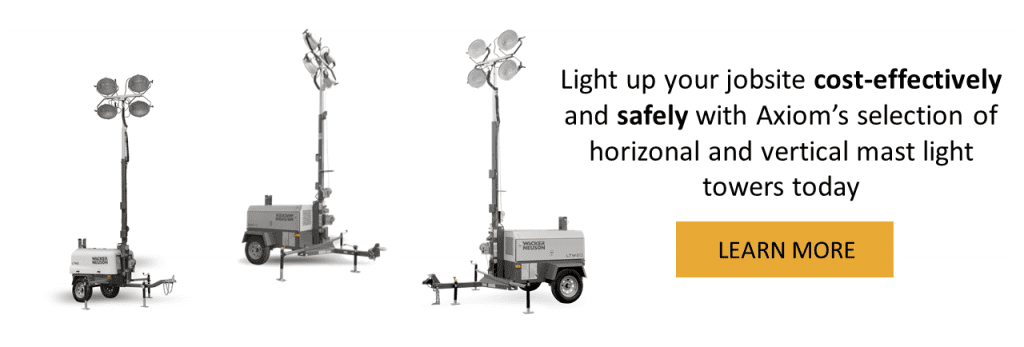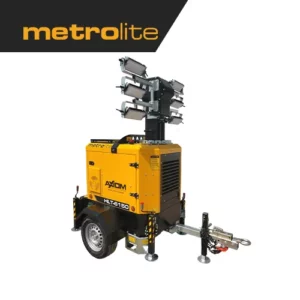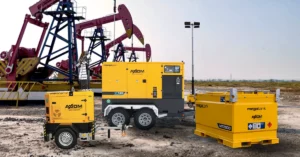
It’s a common practice for diesel-powered equipment to be used as sources for additional power generation, especially when on-site generators are running at full capacity.
Light towers, specifically, can be utilized for their power generation in addition to their use as a light source. A downside to this practice is that wet stacking can occur, causing the built-up, unburned fuel to expel as exhaust.
Not only is this inefficient, but it can also shorten the life of your light towers.
Learn more about wet stacking and how you can prevent it from occurring on your industrial jobsites:
What is wet stacking?
A large percentage of standby power systems use the diesel engine because the compression ignition systems have a much higher thermal efficiency than the spark ignition system used by gas engines.
Like all internal combustion engines, to operate at maximum efficiency, a diesel engine has to have exactly the right air-to-fuel ratio and be able to sustain its designed operational temperature for a complete burn of fuel.
With no spark plugs present, diesel engines rely on the hot compressed air in the cylinder to vaporise and ignite the fuel. When the air is cooler than the design temperature, conditions for combustion are less than ideal.
The fuel ignites and burns, but it doesn’t burn completely. The unburned fuel is exhausted and noticed as wetness in the exhaust system, hence the phrase wet stacking.
The word “stacking” comes from the term “stack” for exhaust pipe.
Typical wet stacking scenarios
At some industrial applications, light towers are used solely as sources of power and not for lighting at all. The lights remain stored inside the body and the generator is relied on to power other equipment or devices.
For example, when a site shack is powered by a light tower, wet stacking of the light tower can occur as the shack does not consume enough power in order for the light tower’s generator to operate at maximum efficiency and burn off all the fuel.
In the case when a 20kW light tower is used solely as a light source, wet stacking can arise as each light only draws 1,000 Watts of power. With four 1,000W lights, the maximum requirement is only 4,000W with nearly 16,000 Watts remaining unused.
In order to avoid wet stacking the light tower generator, plug in additional elements that withdraw the remaining available power.
A commonly asked question is Why would I use a light tower as a source of power and not a generator?
Generally, the intention of using a light tower solely as a source of power is rarely the case; however, in many instances, the equipment is available and there is a need for power to supply other equipment on the industrial jobsite.
How can I tell if my light tower is wet stacking?
Your generator is likely operating inefficiently if any or all of the following conditions exist:
- Continuous black exhaust smoke expels from your exhaust pipe
- The diesel engine is dripping a thick, dark substance from its exhaust pipes
- Soot or hard carbon deposits are forming on the inside of the exhaust stack
Tips to avoid wet stacking
The general rule to avoid wet stacking is to maintain an 80% load on the generator/light during run time.
If the lights mounted on the mast do not draw at least 70% of the generator power, ensure the outlets on the light tower are used to power other industrial jobsite equipment.
Is there a solution for wet stacking?
In the case where a 20kW light tower been wet stacked, turn on all the lights (4,000Watts) and hook up additional equipment drawing 6,000-10,000 Watts (50-80% capacity) and run for a minimum of 8 hours raising the exhaust temperature high enough to vaporize the unburned fuel in the exhaust system and blow out the soot.
If a unit has a history of extended operation at low load, or if there’s no documentation that it’s been exercised recently at adequate load, it’s important to have a professional generator maintenance expert manage the load testing procedure.
Nearly all rental companies supply various sizes of light towers. If you are unsure about your load requirements, renting is likely the best path to choose.
At Axiom Equipment Group, we offer customers the option to trade and/or return your equipment as you need and can offer different combinations of power to fit specific requirements.
Our experienced team has decades of combined experience in equipment rental, sales and service.
At Axiom Equipment Group, we believe in ZERO DOWNTIME so much that we stand behind it with a unique iron clad promise that combines the industry’s most reliable equipment fleet with a rapid response program, around-the-clock availability, expert service and a financing option to fit every budget.
Note: This article includes files from “How to avoid wet stacking light towers,” originally published by Glynn Haughton.






